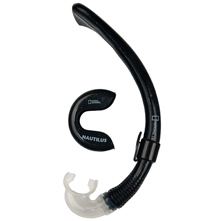To Snorkel or Not to Snorkel: That is the Question
How did this become such a point of contention for so many?
A long debated issue amongst divers, instructors and training agencies is: do divers need to wear snorkels? Before we explore this topic, a little bit of history is in order.
In the beginning, snorkels were a very useful and important piece of equipment. In the early days of SCUBA training, free diving or snorkeling was a big component of the course, acting as an air management tool. Divers were taught to hold their breath and dive down to depths so instructors could assess their comfort in the water.
In addition to cylinder volumes being less, given that SPG’s were not a part of the regulator, the diver only knew the tank was full because the person that filled it said it was. Towards the end of the dive when the “J” valve stopped delivering air and the diver pulled the shepherds hook to get the reserve amount of air to get them to the surface, it was quite possible that the surface swim would have to be performed on the snorkel.
Fast forward to present day: we now have SPG’s, air integrated dive computers, snorkeling skills are not as big of a part of training, and our training materials teach better air management practices. Also, today more divers are going into overhead environments and diving in areas where snorkels become a liability and not an asset. So this brings us to the question: snorkel or no snorkel?
There are still dive sites that require a surface swim, and a snorkel will conserve the air in the cylinder for the dive. There are also locations where snorkels are required by law. In these situations, snorkels are a must.
Where do snorkels become more of a liability? On high current dives, snorkels create a drag and tend to cause the mask to flood. In overhead environments, such as wrecks, swim troughs and caverns, they can cause the divers mask to be dislodged and cause a leak or flood. When diving around kelp or areas where monofilament line is known to be, snorkels become an entanglement hazard.
Another deciding factor is the comfort level of the diver; are you comfortable wearing a snorkel or not? One thing a snorkel should never replace is proper planning of air supply. Divers should always surface with enough air left to make a surface swim to their exit point, be it a boat or shore.
 By breathing off the second stage, the diver avoids the possibility of breathing in water that has entered the snorkel due to choppy surface conditions, waves or poorly aligned snorkel (snorkel leaning too far backward or forward). A variety of pocket snorkels have also entered diving, allowing the diver to “always have one with them” although not necessarily attached until it is needed. With all these details, it’s easy to see wearing a snorkel or not depends on the type of dive that is planned.
By breathing off the second stage, the diver avoids the possibility of breathing in water that has entered the snorkel due to choppy surface conditions, waves or poorly aligned snorkel (snorkel leaning too far backward or forward). A variety of pocket snorkels have also entered diving, allowing the diver to “always have one with them” although not necessarily attached until it is needed. With all these details, it’s easy to see wearing a snorkel or not depends on the type of dive that is planned.There is possibly no better exercise and opportunity to interact with sea life than going out for a swim across the surface of the ocean, lake or river. In this case, a snorkel is exactly the right tool for the job. With the brightest sun light, it attracts the highest concentration of life. Find a good fitting snorkel, mask and fins, and the experience is sure to be amazing!


השאירו תגובה
רוצה להצטרף לדיון?תרגישו חופשי לתרום!